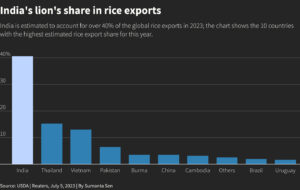India is known as world’s largest rice exporter and producer. India is popularly renowned for agricultural purposes more than any other subject. India banned exports of non-basmati white rice which includes varieties favoured by South Indian communities on 20th July, 2023 as government are supposed to tone down the rising domestic food rates and prices and are going to ensure adequate domestic availability at reasonable prices. The move was designed to help lower rice prices and secure availability in India, according to the government’s statement.
The country accounts for more than 40% of the global rice trade. India is the world’s top rice exporter, accounting for some 40% of the global trade in the cereal including places like Thailand, Vietnam, Pakistan, and the US are the other top exporters. Indica white rice dominates around 70% of the global trade, and India has now put a ban on its export.

This comes on top of the country’s ban last year of exports of broken rice and a 20% duty on non-basmati rice exports. Last year, India exported 22 million tonnes of rice to 140 countries. Of this, six million tonnes were the relatively cheaper Indica white rice. The estimated global trade in rice was 56 million tonnes last year.
Rice prices are currently at a high rise, with El Nino putting further risks on global production in other major Asian rice producers such as Thailand, Pakistan, and Vietnam. It is said that Asia is not the only region hit by India’s rice export ban, many African and Middle East nations are also vulnerable.
This was not India’s first time imposing an export ban on non-basmati rice, but the impact this time could be worse than before. India imposed a ban on non-basmati exports in October, 2007, only to temporarily lift the ban and impose it again in April 2008, sending prices almost 30% higher to stand at the record high of $22.43 per hundredweight (cwt) according to CNBC News. According to an agricultural research company, the International Potato Centre (CIP), the prices increased three times in the span of only six months.

India has a stockpile of an eye-popping 41 million tonnes of rice – more than three times the buffer requirement – in public granaries for its strategic reserve and the Public Distribution System (PDS), which gives more than 700 million poor people access to cheap food.
Over the past year, India has grappled with nagging food inflation – domestic rice prices have risen more than 30% since last October – resulting in increased political pressure on the government ahead of general elections next year. Also, with a host of state-level elections in the coming months, the escalating cost of living poses a challenge to the government.
Devinder Sharma, an expert in agriculture policy in India, says that the government is trying to get ahead of an anticipated production shortfall, with rice-growing regions in the south also exposed to risks of dry rain as the El Nino weather pattern sweeps through later this year.

Many believe India should avoid rice export bans as they are detrimental to global food security. More than half of the rice imports in around 42 countries originate from India, and in many African nations, India’s market share in rice imports surpasses 80%, according to BCC News.
In top consuming countries in Asia – Bangladesh, Bhutan, Cambodia, Indonesia, Thailand, and Sri Lanka, for example – the share of rice consumption in total calorie intake a day range from 40% to 67%. So, these countries are majorly hit by this rice banned by India.
India’s rice export ban could ripple and cause a major harm across global rice markets — and millions are expected to be impacted by this, with Asian and African consumers set to bear the biggest brunt and damage.








